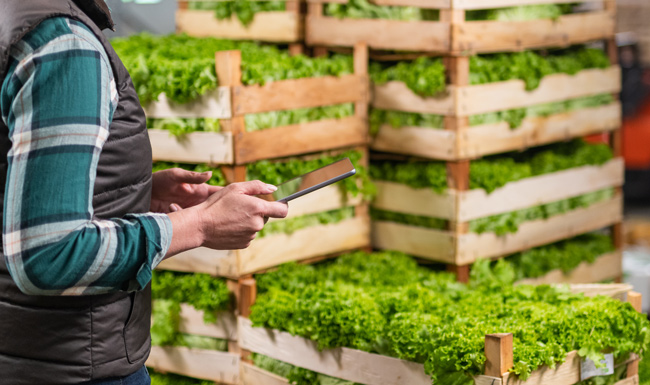
E-Invoicing and Its Geopolitical Stakes
France’s electronic invoicing reform relies on a Y-architecture, where Partner Dematerialization Providers (PDPs) play a central role in issuing and…
Generix Announces the Appointment of Olivier Vaillancourt as General Manager for North America View the press release

Supply chain visibility has become a hot button for corporate leaders as a result of the pandemic, which left many companies reassessing how they obtain, share, and disseminate data with their trading partners. According to PwC, visibility enables companies to know at any given time where a product is in the supply chain.
“This enhances decision making agility for production and distribution decisions,” PwC points out. “Food supply chain visibility is increasingly a standard expectation for consumers, especially with an emerging middle class.”
Where stockouts of critical supplies early in the pandemic—plus ongoing supply shortages—forced companies to pay more attention to this aspect of their operations in 2020, the food supply chain has always been held to a higher level of scrutiny. Pre-COVID, for example, food and beverage companies were already strengthening efforts around “farm to fork” traceability while complying with new government regulations in this area.
This was partly driven by the introduction of the Food Safety Modernization Act (FSMA), which in 2011 shifted the focus from “responding” to foodborne illness to “preventing” it. When it became a law, FSMA expanded the responsibility of ensuring the safety of the food supply to many different points in the global supply chain (for both human and animal food). Last year, pandemic-related challenges pushed the food industry even further down the road to securing high levels of supply chain visibility across manufacturers, farmers, distributors, restaurants, and grocers.
These new obstacles pushed companies to rethink their approaches to supply chain visibility, traceability, and transparency. Where in the past the most popular reaction was to increase inventory levels, this approach consumes working capital, requires extra physical space, and often leaves food companies “holding the bag” on inventory that’s perishable or in danger of expiring. Instead, companies are choosing to implement supply chain solutions such a WMS, MES and TMS that ensure a real time visibility on all inventory and advanced traceability capabilities to pinpoint the origins of a given ingredient quickly and efficiently.
In Food Processing, Robert Swientek explains how the COVID-19 pandemic triggered panic buying and food hoarding that subsequently disrupted the world’s food supply chains. This exposed defects in the industry, leaving some store shelves empty right at a time when an oversupply of food animals crowded farms. Concurrently, goods that would normally be distributed to restaurants had no place to go due to mandatory shutdowns.
“The food supply chain is one of the most critical supply chains in any economy,” Adroit North America’s Richard Sides told Food Processing. “Other events have shaken the food supply chain, like tariffs and foodborne outbreaks, but COVID-19 had a greater impact because it affected the entire process—from the field to the consumer.”
According to Swientek, the nuts and bolts of productive supply chains can be found at the organizational level and in manufacturing plants. “Gaining a better understanding and grasp of your production capabilities, processes and data platforms, demand forecasting, procurement and sourcing and inventory management,” he writes, “can help you optimize your upstream supply chains.”
Now, more companies are turning to supply chain software and platforms that enable end-to-end visibility. “The pandemic has brought a renewed focus for manufacturers in making sure they are becoming more transparent and agile within their supply chain processes,” Niels Anderson writes in Food Safety Tech.
“They are realizing thanks to this disruption that suppliers can’t always deliver and a backup plan is crucial to keep things moving,” Anderson continues. “One option is to implement technology that helps track visibility and transparency to better assess what is needed and to offer alternative suppliers. Having supply chain transparency requires companies to know what is happening upstream in the supply chain and communicate this knowledge both internally and externally.”
Supply chain visibility is about more than just understanding where raw materials and finished goods are at any point in the global supply chain. It’s also about becoming more efficient and profitable. In How Supply Chain Visibility Helps Restaurants Improve Their Business, CH Robinson points to supply chain visibility as being key to managing costs and identifying solutions in the food sector.
“While it has always been important, visibility is now an essential element of successful supply chains,” the transportation provider writes. “Insight to shipment status is only one aspect of true supply chain visibility. Complex supply chains often combine costs, which can impede clear understanding when changes to costs do occur.”
The transportation provider also says that the foodservice industry needs “connected” supply chains. “Simply managing the supply chain isn’t enough in today’s market,” CH Robinson adds. “As the foodservice industry continues to evolve for the future, it’s critical that the supply chain is viewed as a roadmap. Continuous improvement and ongoing supply chain optimization strategies will continue to differentiate acceptable foodservice companies from superior ones.”
Generix Group North America provides a series of solutions within our Supply Chain Hub product suite to create efficiencies across an entire supply chain. Our solutions are in use around the world and our experience is second-to-none. We invite you to contact us to learn more.

France’s electronic invoicing reform relies on a Y-architecture, where Partner Dematerialization Providers (PDPs) play a central role in issuing and…

The B2B mandate in Germany, set to take effect on January 1, 2025, marks a crucial step in the European…

Following the October 15 announcement regarding the abandonment of the PPF development, the DGFIP and its partner AIFE are ramping…

Work with our team to build your ideal supply chain software stack and tailor it to your unique business needs.